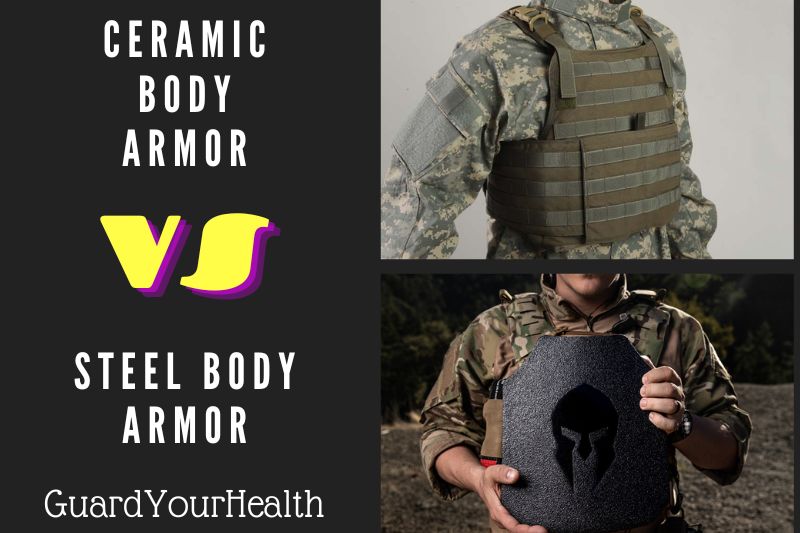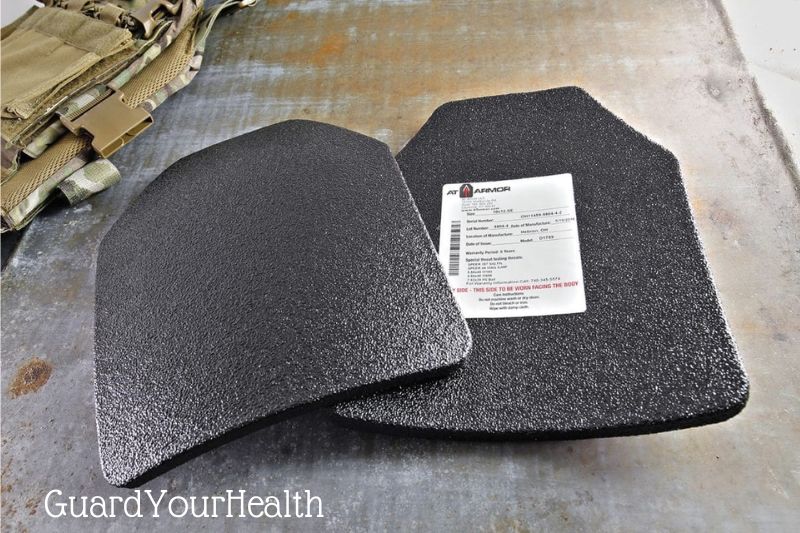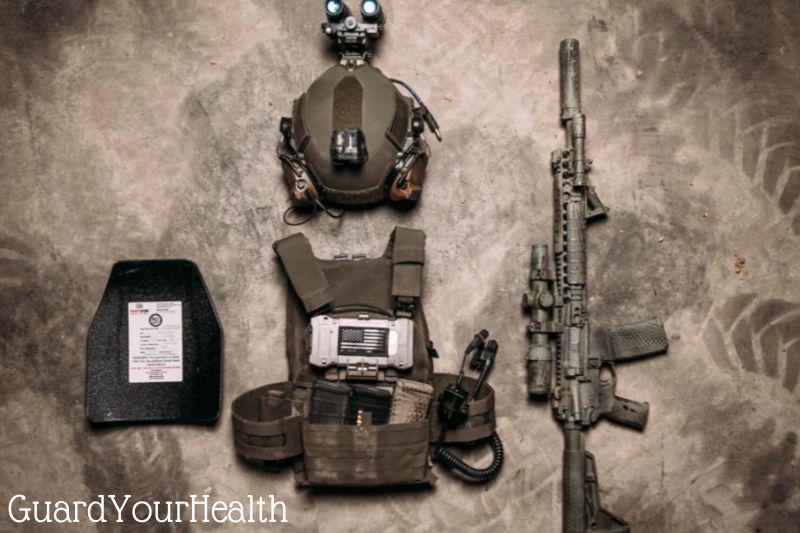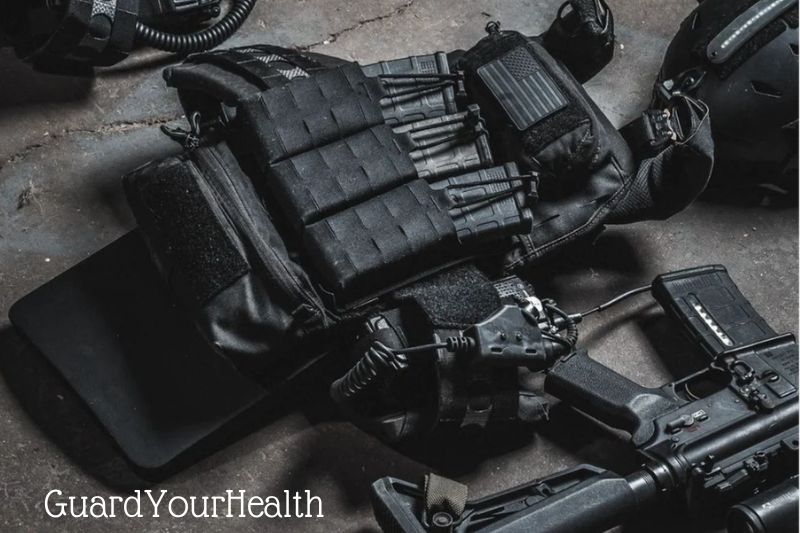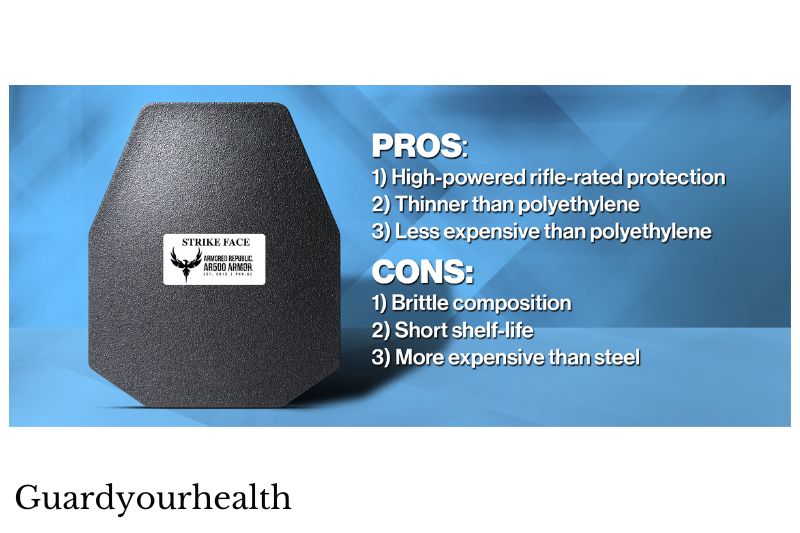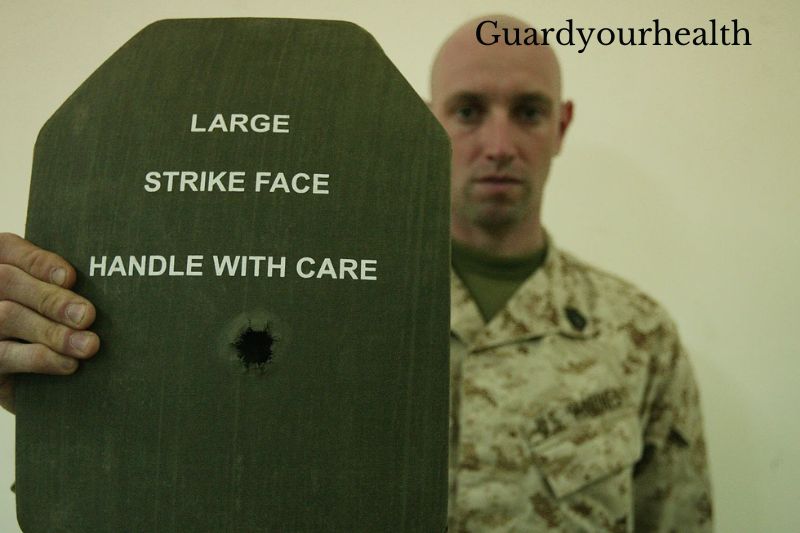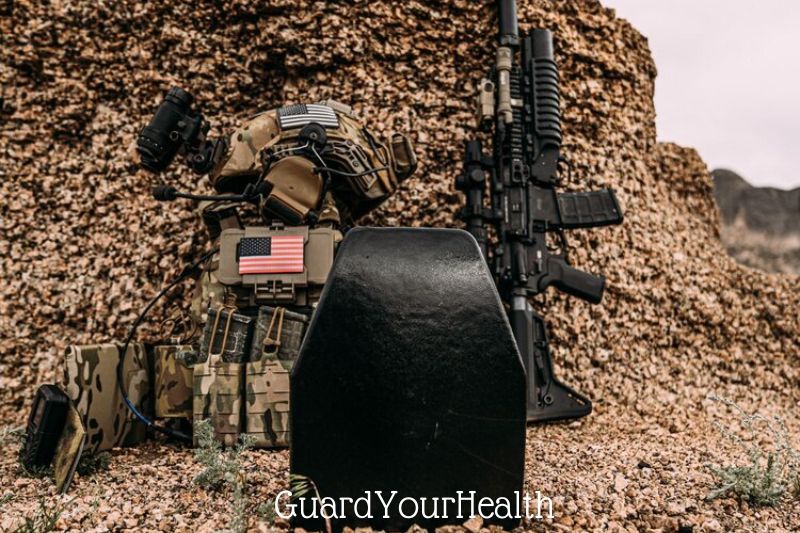There is a debate among law enforcement and military professionals over which type of body armor is better, ceramic or steel. Ceramic body armor is lighter and more comfortable to wear but is also more expensive. Steel body armor is heavier and more difficult to move in, but it is less expensive.
In this blog post, GuardYourHealth will provide you with a full comparison between Ceramic Vs Steel Body Armor. Let’s dive in.
Ceramic Vs Steel Body Armor
Ceramic Plate Body Armor
Ceramic prototypes date back to 1918, but helicopter operators did not employ them in formal operations until the Vietnam War.
Nowadays, ceramic is frequently used as a composite armor to be inserted into the outer layer of soft ballistic vests. One plate may run from the front to the rear, or there may be two plates—one in the front and one in the back. Some vests also include tiny ceramic plates on the sides for added protection.
Designs for ceramic armor can be 3D matrices or monolithic plates. In the former, a single ceramic armor plate is used in place of the steel plate in a conventional ballistic vest.
The latter, on the other hand, consists of ceramic components that are cylindrical, hexagonal, and/or spherical and are held together by thick aluminum or non-armor alloy backing and polyurethane foam.
Body armor made of ceramic can deflect rifle rounds. According to the National Institute of Justice, they offer Type III protection. A Type 3 NIJ plate weighs around 4 to 8 pounds, or 1.8 to 3.6 kilograms, for the typical 10′′ by 12′′ dimensions. However, different kinds of ceramic plates, such as level 4 ceramic body armor, are available in various sizes and provide various levels of protection.
There are full-body ceramic armors in addition to body armors with ceramic plates. They are still available on the market as an alternative, but the majority of staff will not suggest them for a few reasons.
They are big and hefty to start with. They may impede your movements and be difficult to deal with. Entering and exiting automobiles is challenging, and even bending over can be challenging. Your ability to fire is also impacted by restricted mobility, in addition to your stealth and reflexes.
Second, ceramic body armor needs to be replaced every 5 to 7 years. These armors constitute a cost-effective or economical choice given their high price.
Third, full-body armor made of ceramic may crack upon impact. It can stop one to three bullets, although its stopping power is limited. It is quite likely that your armor will break in a fight where you are struck more than three times.
Fourth, ceramic armor needs special maintenance. They can break and become unusable even before you use them, so you can’t just throw them in the back of your trunk, locker, or closet.
Fifth, it could be challenging to find fractures on them. In extreme circumstances, it could be necessary to use X-rays to detect whether they have been shattered. Of course, doing this will increase your expenses.
Steel Plate Body Armor
Steel body armors are on the other end of the spectrum. They have been around longer than ceramic armors, and many merchants still sell them now. One well-known illustration is AR500 armor. So if you Google “AR500 armor vs. ceramic,” you can find a lot of results.
Like ceramic body armors, steel body armors can be worn as full-body armor or as plates inside a vest or suit. The designs can be monolithic plates or systems incorporating matrices.
Like ceramic plates, steel plates are available in a variety of sizes and shapes. Nowadays, plates have gravestone-like angle cuts at the top so they won’t interfere with the shouldering of a weapon. Yet the majority are straight, not curved.
Curved plates are more comfortable but have a higher chance of ricocheting. Steel armors tend to be straight and uncomfortable as a result, making it difficult for the wearer to move around and perform simple tactical moves.
The typical 10 by 12-inch plates will protect the heart, lungs, and part of the spine, but they won’t cover the sides of the rib cage, head, or pelvis. There are then 6 by 6-inch side plates in such a situation. Additionally, there are larger 10 by 13.5-inch plates for the chest and back. However, they are heavier and need a larger carrying pocket.
The two main benefits of steel versus ceramic are their lower cost and longer lifespan. Steel ceramic body armors only cost $129 to $139 on AR500 Armor. However, ceramic body armors can cost up to $249.
Ceramic body armors can survive for five to seven years, as was previously mentioned. Steel body armor, in contrast, won’t need to be renewed for 15 to 20 years.
Steel is not light, though. Instead, it is unpleasant and stiff. Most steel plates are between 7 and 8 pounds in weight and 0.25 inches thick on average. Therefore, they can make you tired and possibly slow you down. Weight comparison of ceramic and steel plates reveals that the latter is lighter.
Steel plates that cushion the torso area also trap heat. This is advantageous in cold climates but unpleasant in the hot sun.
Most steel armors are unable to deflect penetrating bullets. And they are not impact-absorbing. Therefore, if you are wearing steel armor, taking a hit will feel like you have been pinned down quite firmly. This can occasionally result in fractured ribs and compressed lungs.
Additionally, steel armors have the potential to ricochet. It seems like a good bargain, but it’s not since it changes the trajectory of bullets by redirecting the energy of hits and strikes. Why? Imagine a bullet hitting your arm after bouncing off your steel body armor (awesome!).
Recap – Steel vs Ceramic Plates Body Armor
- Steel is heavier than ceramic in terms of weight.
- Steel lasts longer than ceramic, which needs to be replaced after fewer years.
- Steel is less expensive than ceramic in terms of price.
Pros and Cons Of Ceramic Armor
Pros
- Ceramic is typically about 5–6 lbs. per square foot as opposed to 10.2 for steel, making it more lightweight.
- Steel is less effective than ceramic at absorbing and distributing energy. Fewer sternum fractures, shattered ribs, and lung collapses will be the result of this.
- Ceramic does better against supersonic armor-piercing bullets than steel.
- To lessen a bullet’s force, add Kevlar to ceramic. Ceramic plates are better-protected thanks to this modification.
Cons
- Ceramic plates are frequently heavier and less mobile than metal ones.
- Ceramic plates cannot support multiple rounds in the same location. A ceramic plate typically breaks on contact when it is struck. It works well at stopping one to three rounds, while steel is superior at stopping several rounds.
- Steel plates cost a lot less than ceramic plates.
- Compared to steel plates, ceramic plates require more upkeep and attention. Additionally, ceramic will only last about 5-7 years as opposed to 15-20 for steel.
Pros and Cons Of Steel Armor
Pros
- Steel requires less maintenance than ceramic, polyethylene, or Kevlar. Steel can endure a hammering without the armor losing its protection very quickly.
- The least expensive material for armor is steel.
- Steel can withstand several blows without breaking down and making you defenseless.
- Steel is more covertly used than the majority of Kevlar and ceramic plates.
Cons
- The energy of a bullet moving at 3,300 fps will pass through the plate and into your chest because steel is stiff and strong. Steel will protect you from the penetration, but if hit in the proper place, you might even collapse a lung in addition to breaking ribs and the sternum.
- Steel is far more unpleasant than any other armor since it is more difficult to mold to your body.
- The heaviest material used for armor is steel. Typically, it’s 10.2 pounds per square foot.
- Steel armor is specifically vulnerable to projectiles that are designed to penetrate armor.
- Steel armor deflects the trajectory of the bullet by absorbing its energy. As a result, even though you are shot, the force won’t cut through your skin. A bullet can ricochet off the steel and into your arm, leg, or other soft tissue if it is struck from the side.
So, Steel Plates Vs Ceramic: Which Armor Do I Choose?
It will depend on your needs and the threat levels you are exposed to. Most of us don’t regularly engage in life-or-death situations, assault terrorist strongholds daily, run kilometers in our plate carriers, etc.
Where will this be used the most, be honest with yourself? Are you putting it in the heated trunk of your car to bounce about in case the worst happens? If so, steel plates will unquestionably safeguard you when you need them if you’re like the majority of folks.
However, you might want to invest in ceramic if you constantly feel the need to save the planet.
The most crucial thing to remember is that all of our armor will keep you safe and get you home regardless of what you wear. Any protection is preferable to none. Grab a set of steel plates if money is an issue.
Alternately, choose ceramic if hefty steel makes it less likely that you’ll wear it when you need it. The fact that you have something is what matters most.
FAQs
1. Steel or ceramic plates are used by the military.
That is why the United States military employs ceramic plates and Kevlar body armor. It not only protects troops but also gives them the mobility they need to do their jobs in a hostile environment.
2. Is ceramic armor bulletproof?
Excellent bulletproofing effect
Ceramic plates have a much higher bulletproof capability than traditional metal plates due to their unique molecular structure. These ceramics are frequently a composite blend.
3. Are ceramic armor plates brittle?
Although ceramic protection plates can withstand the impact of a high velocity round, they are breakable and can be easily damaged or even shatter if dropped. A small chip or hairline crack that is not visible to the naked eye can compromise the plate’s integrity and ability to stop incoming rounds.

